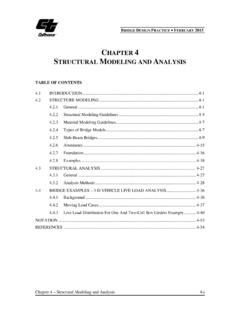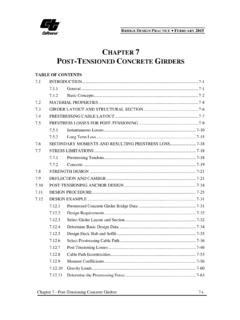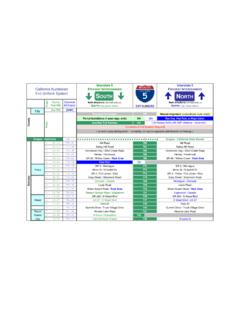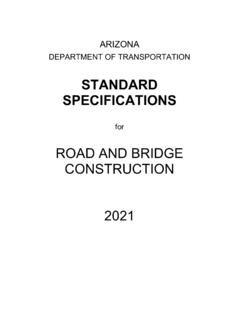Transcription of Chapter 300 - Geometric Cross Section
1 Highway Design Manual 300-1 July 1, 2020 Chapter 300 Geometric Cross Section The selection of a Cross Section is based upon the joint use of the transportation corridor by vehicles, including trucks, public transit, cyclists and pedestrians. Designers should recognize the implications of this sharing of the transportation corridor and are encouraged to consider not only vehicular movement, but also movement of people, distribution of goods, and provision of essential services.
2 Designers need also to consider the plan for the future of the route, consult Transportation Concept Reports for state routes. Topic 301 Traveled Way Standards The traveled way width is determined by the number of lanes required to accommodate operational needs, terrain, safety and other concerns. The traveled way width includes the width of all lanes, but does not include the width of shoulders, sidewalks, curbs, dikes, gutters, or gutter pans. See Topic 307 for State highway Cross sections, and Topic 308 for road Cross sections under other jurisdictions.
3 Index Lane Width The minimum lane width on two-lane and multilane highways, ramps, collector-distributor roads, and other appurtenant roadways shall be 12 feet, except as follows: For conventional State highways with posted speeds less than or equal to 40 miles per hour and AADTT (truck volume) less than 250 per lane that are in urban, city or town centers (rural main streets), the minimum lane width shall be 11 feet. The preferred lane width is 12 feet. See Index for place type definitions.
4 Where a 2-lane conventional State highway connects to a freeway within an interchange, the lane width shall be 12 feet. Where a multilane State highway connects to a freeway within an interchange, the outer most lane of the highway in each direction of travel shall be 12 feet. For highways, ramps, and roads with curve radii of 300 feet or less, widening due to offtracking in order to minimize bicycle and vehicle conflicts must be considered. See Index and Table For lane widths on roads under other jurisdictions, see Topic 308.
5 Class II Bikeway (Bike Lane) Lane Width (1) General. Class II bikeways (bike lanes), for the preferential use of bicycles, may be established within the roadbed and shall be located immediately adjacent to a traffic lane as allowed in this manual. A buffered bike lane may also be established within the roadbed, separated by a marked buffer between the bike lane and the traffic lane or parking lane. See the California MUTCD for further buffered bike lane marking and signing guidance.
6 Contraflow bike lanes are designed for bike travel 300-2 Highway Design Manual July 1, 2020 in the opposite direction as adjacent vehicular traffic, and are only allowed on one-way streets. See the California MUTCD for contraflow bike lane marking and signing guidance. Typical Class II bikeway configurations are illustrated in Figure A bikeway located behind on-street parking, physical separation, or barrier within the roadway is a Class IV bikeway (separated bikeway).
7 See DIB 89 for Class IV bikeway (separated bikeway) design guidance. The minimum Class II bike lane width shall be 4 feet, except where: Adjacent to on-street parking, the minimum bike lane should be 5 feet. Posted speeds are greater than 40 miles per hour, the minimum bike lane should be 6 feet, or On highways with concrete curb and gutter, a minimum width of 3 feet measured from the bike lane stripe to the joint between the shoulder pavement and the gutter shall be provided.
8 Class II bikeways may be included as part of the shoulder width See Topic 302. As grades increase, downhill bicycle speeds can increase, which increases the width needed for the comfort of bicycle operation. If bicycle lanes are to be marked, additional bike lane width is recommended to accommodate these higher bicycle speeds. See Index (4) for guidance on accommodating bicyclists on uphill grades where a Class II bikeway is not included. If bike lanes are to be located on one-way streets, they may be placed on either or both sides of the street.
9 When only one bicycle lane is provided, it should be located on the side of the street that presents the lowest number of conflicts for bicyclists which facilitates turning movements and access to destinations on the street. (2) On-Street Parking Adjacent to Class II Bikeways. Parking adjacent to bike lanes is discussed in subsection (1) above and addressed in Table , Note (7). Part-time bike lanes with part-time on-street parking is discouraged. This type of bike lane may only be considered if the majority of bicycle travel occurs during the hours of parking prohibition.
10 When such an installation is being considered refer to the California MUTCD and traffic operations for direction regarding proper signing and marking. (3) Reduction of Cross Section Elements Adjacent to Class II Bikeways. There are situations where it may be desirable to reduce the width of the lanes in order to add or widen bike lanes or shoulders. In determining the appropriateness of narrower traffic lanes, consideration should be given to factors such as motor vehicle speeds, truck volumes, alignment, bike lane width, sight distance, and the presence of on-street parking.












